Google adds website links to ‘Call Ads’
The optional link relieves call-volume pressure and can result in 'fewer accidental calls and more qualified leads' says the company.
Google announced that marketers can now add website links to Call Ads. The idea is to give consumers another way to contact and engage with the business during a time when call volumes are very high and wait times may be long — risking a bad customer experience.
The mock-up below shows a traditional Call Ad, but with a new “visit website” link immediately below the description. This is optional, not mandatory.
Link makes the ad size larger. Google makes the point that adding the link expands the size of the Call Ad, “giving you greater visibility on the search results page.” Call Ads only appear on devices capable of making phone calls, so effectively smartphones (although tablets can often make calls).

Users will only visit the designated website if they click on the link. Tapping the ad anywhere-else initiates a phone call. To include a site link, you need to add the desired URL to a new or existing ad. Google also reminds marketers to track calls from their websites to get a complete reporting picture.
More qualified leads, fewer mistaken calls. Call-Only Ads were originally introduced in 2015 for marketers who just wanted to drive phone calls. Last year, Google expanded the character count in Call Ads’ headlines and descriptions. It also moved the business name to the beginning of the ad-description text.
Google argues inclusion of the new site link will result in “fewer accidental calls and more qualified leads.” The company also says, “[Y]ou can now engage consumers who may only be interested in visiting your site, and may not have previously interacted with your brand.”
According to benchmarking data from Wordstream, Call Ads typically have higher CPCs than traditional text-ads but can have lower CPAs.
Why we care. Google’s move makes a lot of sense. While driving directions have fallen way off (for obvious reasons), call volumes have increased in many categories. Some enterprises (e.g., banks) are reporting massive hold times, and some smaller businesses don’t have the resources to field calls right now. So the option to answer questions on a website relieves some of that pressure. It also gives consumers more choices about how they get information.
Contributing authors are invited to create content for Search Engine Land and are chosen for their expertise and contribution to the search community. Our contributors work under the oversight of the editorial staff and contributions are checked for quality and relevance to our readers. The opinions they express are their own.
Related stories
New on Search Engine Land